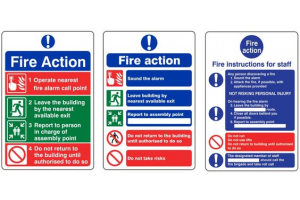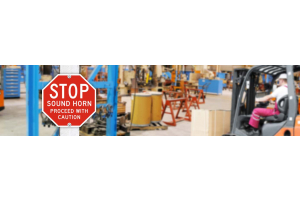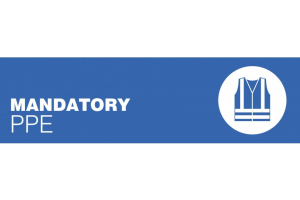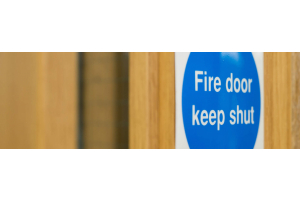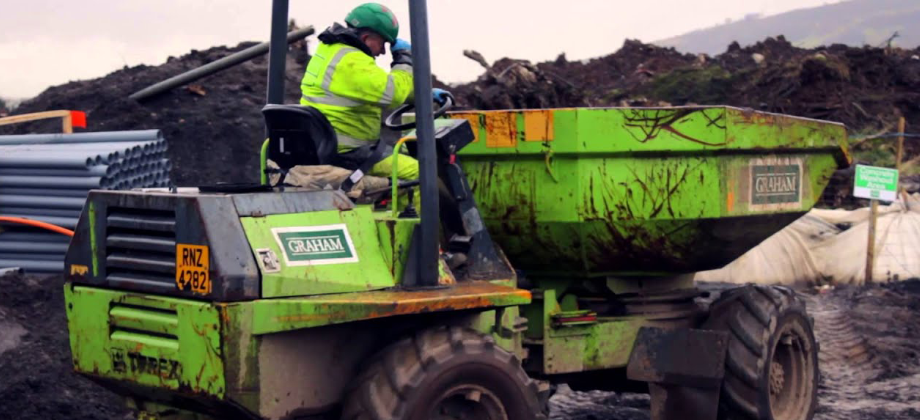
Site traffic and mobile plant
Every year, workers are killed on construction sites by moving vehicles or by vehicles overturning. Many more are seriously injured in this way. The risks can be reduced if the use of vehicles and mobile plant is properly managed. Plan and manage your site to minimise the number of vehicle movements; Design groundworks/landscaping to minimise the need to import fill or take spoil off site. Try to reuse spoil close to where it was excavated to reduce the distance it has to be carried. Limit the number of vehicles on site:
- provide car and van parking for the workforce and visitors away from the work area and strictly control parking within the work area;
- use gates or barriers etc to control entry into the work area and display the procedure for obtaining entry (eg a mobile phone contact number)
- plan the location of stores/goods receiving areas carefully to reduce any need for delivery vehicles to travel through site. You may need to relocate those areas as the site progresses.
Consider ways other than vehicles, of moving materials to where they will be used (eg self-erecting tower cranes). Such approaches can be particularly useful on sites with limited space available for access. Plan and manage the routes on your site, Set appropriate speed limits for the routes on your site. Sign the limits clearly and consider using physical measures to restrict speeds (eg road humps). Reversing vehicles are a major risk. Wherever possible plan your site layout to avoid the need for vehicles to reverse: provide drive-in/drive-out access to delivery and work areas. You may need to add extra temporary roadways to the site’s permanent road system and/or delay building parts of the project to allow exit routes from dead ends where roadways are narrow, or are constricted by parked vehicles or stored materials, you may need to implement a one-way system; design storage compounds to allow drive-through deliveries and collections; where drive-through routes cannot be incorporated, provide turning circles to allow vehicles to turn round without reversing, or provide a ‘hammerhead’ or similar turning area. You will need to fence off any turning areas to exclude all pedestrians, and they should be kept free from obstructions and parked vehicles.
If vehicles have to reverse in areas where pedestrians can not be excluded you should ensure that: the driver has sufficient direct vision behind the vehicle to reverse safely; or the vehicle is fitted with appropriate reversing alarms, vision aids such as mirrors, CCTV etc; and/or a trained signaller is used to control the manoeuvre. Plan to keep pedestrians and vehicles apart: provide separate entry and exit gateways for vehicles and pedestrians; provide firm, level, well-drained pedestrian walkways that are separated from vehicle routes and, as far as possible, take the most direct route (it is easier to make vehicles go the long way round); where walkways need to cross vehicle routes, provide a clearly signed, well lit crossing point. Make sure both drivers and pedestrians can easily see each other as they approach the crossing; and at site exits where vehicles may have to cross the public footpath, ensure that vehicles leaving site can see both ways along the footpath before they need to cross it by, eg constructing the site fence on either side of the gateway of welded mesh or other materials that do not obstruct vision, or setting the gateway back from the footpath and angling the site fence to allow a wide field of view.
If sufficient vision cannot be achieved, then a trained signaller should be used to control exiting vehicles.
- Where vehicles and pedestrians need to share a route or working space:
- provide separate walkways alongside the vehicle route.
- Make sure the walkways are wide enough so that pedestrians can pass without stepping into the roadway
- keep walkways clear of obstructions, excavations etc.
If walkways have to be blocked, provide a safe diversion
- consider separating the walkways from the roadways by at least a waist-high fence or barrier in areas of increased risk such as: turning areas
- high traffic routes, entrances and exits, narrow roadways or walkways, areas with restricted vision, near loading bays, stockpiles, lorry unloading areas, storage areas and other ––places where reversing is likely to occur; in other areas it may be sufficient to use a raised kerb or marker posts to delineate the pedestrian and vehicle routes.
- ;
Take particular care at locations where pedestrians and vehicles are forced together. These locations may be permanent (such as gateways, bridges, ramps or gaps between buildings) or temporary, perhaps due to excavations or access equipment, make sure that drivers and pedestrians on shared routes can see each other easily; you may need to provide lighting after sunset or in bad weather.
Pedestrians should wear high-visibility clothing; if it is necessary to undertake work on a vehicle route (eg repairing kerbs, accessing manholes or gullies etc) then treat it like work on a public road. Protect the work zone with barriers and provide advance warning signs and cones that are appropriate to the type and speed of the traffic, Provide drive-in/drive-out access to delivery and work areas.
Signs and instructions
- Make sure that all drivers and pedestrians know and understand the routes and traffic rules on the site and provide induction training for drivers, workers and visitors.
- Post plans showing the traffic routes at site entrances, site notice boards and in other places where workers can easily refer to them.
- Consider providing printed copies that can be marked up as necessary to guide delivery drivers.
- Update the notices and provide retraining if traffic routes or rules change.
- Provide standard road signs to warn, guide and instruct drivers on site.
- In particular, make sure that routes for delivery drivers and site visitors are clearly signed.
Work areas; The risks from working plant must be controlled: protect any temporary structures, such as scaffolds or false work, which might be damaged and made unsafe if struck by a vehicle; protect any excavations and alongside any areas of water if vehicles may approach close by; take precautions, such as stop blocks, where vehicles tip materials into excavations, make sure vehicles are not overloaded as it may obstruct the driver’s view and they may become unstable, difficult to steer or the brakes may be inadequate to stop the vehicle; segregate the area around plant that slews (eg 360° excavators and mobile cranes). Do not rely on the driver using mirrors, cameras etc to check that the slewing area is clear, as their attention will typically be concentrated on the machine boom or jib; if slewing plant is being used in a confined area where there is a risk of workers being trapped against adjacent obstructions (ie less than 0.5 m clearance), consider using a different type of machine that has zero or minimal tail swing. If alternative machines are not practicable, then secure fencing should be used to segregate the area and prevent access into the danger zone, Take precautions, such as stop blocks, where vehicles tip materials into excavations, Minimal tail swing.
Many workers, including drivers, are injured when vehicles unintentionally move: park vehicles on level ground. Avoid parking or stopping any vehicle on a slope, handbrake malfunctions are a common contributor to run-away accidents; certain types of construction plant can drive up slopes that are steeper than the vehicle’s normal handbrake can hold them on – check safe slopes with the vehicle supplier; and turn off the engine before leaving a vehicle. There have been numerous incidents where drivers have accidentally operated control levers while climbing in or out of the vehicle. Leaving the engine running also encourages unauthorised use.
Vehicles and plant
For any particular task there is often more than one item of plant or type of vehicle that could undertake it. Selecting the right plant or vehicle can make the job significantly safer. Select the size of plant or vehicle carefully. If it is too small there can be a temptation to overload the machine and it may not have sufficient stability. If it is bigger than necessary it is likely that it will be more difficult to manoeuvre and the driver will have less visibility. Select the type of plant carefully. In congested areas or where it is not possible to exclude pedestrians, consider using a zero tail swing 360° excavator, or a 180° excavator (backhoe loader). Tracked dumpers have better stability on slopes and on soft ground than wheeled dumpers. Many construction vehicles have significant blind spots (areas that the driver cannot see) in various locations around the vehicle. In some cases this can create risks to both nearby pedestrians and to the vehicle when the vehicle is moving. Any load that the vehicle is carrying can create temporary blind spots. Select vehicles with the best view around them directly from the driver’s position.Often it is the more recent models that have better direct vision. Avoid fitting additional components onto a vehicle in positions that obstruct the driver’s view, eg racks to carry security grilles or supplementary exhaust filters. Some vehicles are fitted with vision aids such as mirrors or CCTV, which help drivers to see areas that they cannot view directly. If these aids are fitted make sure they are working, properly adjusted and that the driver has been instructed in their use. If the driver has restricted direct vision to the rear, the vehicle should be fitted with a reversing warning signal. Driver vision, vision aids and warning signals should never be used as the only precaution. The precautions from site management, planning and layout should be fully implemented first.
Some vehicles are fitted with vision aids such as mirrors or CCTV, which help drivers to see areas that they cannot view directly, If there are blind spots remaining around a machine, decide whether any further action is required. Consider: what blind spots remain (including any created by typical loads); the ways in which the machine can move and the position of any danger zones caused by those movements; and whether pedestrians, vulnerable structures, and anything that might cause the vehicle to overturn are effectively prevented from being in any danger zone that the driver cannot see. If further action to control the risks is necessary, review the site layout and management arrangements for avoiding such risks. If the risk cannot be removed by site changes, consider fitting additional vision aids or using a properly trained signaller to assist the driver. Make sure drivers are aware of the areas of limited visibility. Warn other workers as part of their induction. Keep cab windows and any vision aids clean.
Inspection and maintenance
Construction vehicles work in harsh environments and require effective maintenance. A programme of daily visual checks, regular inspections and servicing schedules should be established according to the manufacturer’s instructions and the risks associated with the use of each vehicle. Plant hire companies should provide information with all plant and equipment they supply, to enable it to be used and maintained safely. Vehicles should have a maintenance log to help manage and record maintenance operations. Drivers should be encouraged to report defects or problems. Reported problems should be put right quickly and if they are safety critical, the machine should be taken out of use until they are repaired. Planned inspection and maintenance needs to follow the manufacturer’s guidelines and is likely to include, where appropriate: braking systems, including the handbrake; seat belts; tyres, including condition and pressures; steering; windows, windscreen washers and wipers; mirrors, CCTV, and other vision aids; safety devices such as interlocks or isolation devices; warning signals; driver protection, eg roll over protective structures (ROPS) and falling object protective structures (FOPS); lights and indicators; functional checks on controls; correct location of guards and panels; fire-fighting equipment.
Training and competence
Many accidents are the result of untrained or inexperienced workers driving construction vehicles. The use of any site plant or vehicle should be restricted to competent drivers who have been authorised to operate that vehicle. Help prevent any unauthorised use by: only allowing authorised drivers to hold vehicle keys. Drivers should not loan keys to other workers; instructing drivers to turn off a vehicle’s engine and remove the key whenever they leave that vehicle; ensuring all vehicles are securely immobilised whenever the site is unoccupied. Driver competence may be judged on the basis of experience, recognised training and testing of knowledge and ability. Certificates of training from recognised training schemes help demonstrate competence in operating a general class of plant or vehicle. Training certificates should be checked for validity and training records should be kept up to date. Drivers should also be trained in the safe operation of the specific machines that they are required to drive. This may include: layout and operation of the controls; stability limits; limits on drivers’ vision and the use of any vision aids; daily checks, and how to do them safely. No-one unfit to drive through the influence of alcohol, drugs or medication should be permitted to drive any vehicle. Consider providing a daily briefing to drivers to update them on any problems with traffic routes or areas where other activities might cause difficulties.
Signallers
Signallers used to direct vehicle movements need to be competent to undertake the task safely. They are often the person closest to a moving vehicle and therefore they can be at significant risk of being struck by that vehicle unless they and the driver work safely. No one other than trained and authorised signallers should attempt to direct vehicle movements, Wherever possible provide signallers with a protected position from which they can work in safety. Signallers should be easily distinguished on site, eg by providing them with distinctive clothing. Drivers under the control of a signaller should be instructed that if they cannot see the signaller they should stop immediately. A checklist for signallers’ safe working practices can be found in Safe use of machinery on construction sites.
Workforce
It is likely that every worker on site will need to travel on foot. As part of the general induction, all workers should be instructed in the safe pedestrian routes on the site, and in any site rules controlling pedestrians. It is also likely that many workers will, at some time, need to approach a working machine. They should be instructed in a safe procedure for making the driver aware of their intention to approach, and ensuring that the machine is safely at rest before they approach. Do not let anyone ride on vehicles or mobile plant except where the vehicle has been designed to carry a passenger.
